
by Lorri | May 9, 2018 | UnCorked
My family loves pizza.
What makes pizza — a near perfect food — even better? Pairing it with the perfect wine. For many years I have been consuming pizza with wine but usually I order the house wine in pizza restaurants or drink what we have on hand in our home. But recently I have been exploring pairings that make this food and wine combination even better.
Pizza already has acidity from the rich tomato sauce, fattiness and salt from the cheese and then there’s a range of options when it comes to the toppings.
Italian Chianti, made from the legendary sangiovese grape, has always been a classic pizza pairing. This pairing fits with one of the general food and wine pairing rules: Drink a wine from the same regions as the cuisine. But there are many exciting options for pairing this now-American staple.
Barbecue Chicken Pizza is quickly becoming one of my favorites. I admit it could be that I enjoy anything barbecue because of the savory-smoky flavors. The barbecue sauce on the pizza brings out many exciting flavors when you add cheeses and spices. Malbec tends to be fruit forward and works with the sweeter styles of most barbecue sauces.
THE VALUE
- 2016 Alamos Malbec, Argentina (about $10 retail)
THE SPLURGE
- 2016 Bodega Norton Reserva Malbec, Argentina (about $16 retail)
Hawaiian Pizza is one of my husband’s favorite pizzas and I am always looking for the ideal match. If you consider wine and food pairing advice of the past, a pizza topped with meats is usually considered to match only with a red wine. But during my exploration one of my favorites has been a slightly sweet riesling. The acidity in the riesling acts as a palate cleanser and the slight sweetness brings out the best in the salty ham and sweetness of the pineapple.
THE VALUE
- 2016 Chateau Ste. Michelle Riesling, Washington (about $12 retail)
THE SPLURGE
- 2016 Trimbach Riesling, France (about $27 retail)
Meat pizzas — especially with sausage toppings — pair with fuller bodied red wines. Pepperoni gives pizza a meaty spicy flavor matching perfectly into the bold peppery style of the syrah grape. The rich meats with spices generally including fennel, anise, thyme and oregano bring out the intense flavors of this wine.
THE VALUE
- 2016 Cline Cellars Syrah, California (about $13 retail)
THE SPLURGE
- 2016 Bell Syrah Canterbury Vineyards, California (about $28 retail)
Pizza Margherita is sometimes put into the same category of wine pairings as a simple cheese pizza. But the aromatic notes of fresh basil and the saltiness of the fresh mozzarella offer much more to pair with a wine also offering aromatics. A dry rose brings an ideal pairing with this pizza style.
THE VALUE
- 2016 Apothic Rose, California (about $13 retail)
THE SPLURGE
- 2016 Presqu’ile Winery Rose, California (about $20 retail)

by Lorri | May 2, 2018 | UnCorked
I keep my eye on grape varieties getting attention and for selfish reasons am always looking for great value wines I can add to my everyday drinking shopping list. Barbera is such a grape.
In the past, most of us only thought of this grape as a blending partner, overshadowed by the famous Barolo wines of Italy. But over the past decade we are seeing this grape stand on its own as a sought-after wine. Why have American consumers been left out on this wine? The simple answer may be the Italians were keeping this secret to themselves, keeping almost all of the wines produced for local consumption.
This grape grows throughout the world, but most famous are the vineyards of Piedmont, Italy, that for centuries have produced the most concentrated and complex examples. It’s considered the “workhorse grape” for Italian winemakers because of its hardy growing traits that thrive in most soils and climates.
Most think of Piedmont for the famous nebbiolo grape used in the coveted Barolo and Barbaresco wines. But barbera is known in this region to locals as “the people’s wine” as almost half of the everyday house wines or table wines in Italy are made from this grape. It is the third most planted grape in the entire country and almost 1,000 years older than the well-known cabernet sauvignon.
Because barbera is very low in mouth-drying tannins but high in acidity, it is a dream for wine and food pairing. It’s one of the Italian grapes I have found that simply matches with almost any food. It can be deceiving because the wine is very dark in color and most are expecting a tannic full-bodied style similar to cabernet sauvignon and zinfandel, but the taste is generally light and refreshing. It has flavors of cherry, strawberry and raspberry when it’s young, and as it ages can deliver the undeniable “truffle” aromas and flavors reminiscent of the great wines of Piedmont.
The best examples are from the town of Asti. This town has been producing affordable barbera for centuries. Look for the name Barbera D’Asti on the label.
THE VALUE
- 2016 Araldica Albera Barbera D’Asti, Italy (about $12 retail)
THE SPLURGE
- 2011 Michele Chiarlo Barbera D’Asti, Italy (about $22 retail)

by Lorri | Apr 18, 2018 | UnCorked
You may have seen the words “sur lie” on the label of wine bottles. Sur lie is French for “on the lees,” but what exactly are wine lees and what do they do?
Simply put lees are sediment and sur lie means the wine was aged with this sediment.
As a wine ferments the lees fall to the bottom of the tank in two stages. The first is known as “gross lees” and the other “fine lees.”
Gross lees are the heavier particles made of leftover sediment such as stems, seeds, pulp and even dirt. These are generally racked off — racking is the process of moving wine from one barrel to another using a siphon and gravity rather than a pump to avoid stirring up sediment (i.e. lees) — immediately after fermentation. Too much contact with gross lees can be harmful to wine and lead to spoilage or undesirable flavors.
Fine lees, composed primarily of dead yeast cells, are quite desirable. Contact with fine lees is an important part of the winemaking process as fine lees impart complexity and richness to a wine.
For white wines, a key function in keeping a wine on the lees is for oxygen absorption. This acts to protect a wine from oxidation and preserve youthful and fresh characteristics. The key is the amount of time and the balance in stirring these dead yeasts. The perfect technique will give wines an added texture and generally make the wine smoother on the palate. Another technique in this process is “batonnage” where the settled lees are stirred in the wine. It is important in the process because it promotes integration and keeps the lees from compacting and bringing in undesired hydrogen sulfide odors.
Another technique is autolysis. It may not sound enticing, but this process involves the decaying dead yeast cells bursting, and thus imparting flavor to the wine. Some of the greatest Champagnes can spend decades in the process as they mature in bottles inside cellars. The yeast cells die in the bottle once sugar has been consumed — ending the second fermentation. This means that these wines are coming into close contact with fine lees left in the bottle and over time this is what creates the flavors of biscuits and bread we love so much in these exceptional wines.
THE VALUES
- 2015 Charles and Charles Chardonnay, California (about $15 retail)
- 2015 Sauvion Muscadet Sevre-et-Maine, France (about $17 retail)
THE SPLURGES
- 2014 FEL Chardonnay, California (about $32 retail)
- 2013 Hahn SLH Chardonnay, California (about $20 retail)
- 2015 La Cana Albarino, Spain (about $19 retail)

by Lorri | Apr 11, 2018 | UnCorked
If you know me well, you know I am always one to celebrate — even if I’m a little late sometimes. Uncorked turned 13 last month. For me, each year is a monumental milestone and a reflection on how much I truly enjoy writing this column for my readers. In addition to my love and passion for learning more about wine, it’s your feedback, ideas and your questions that make it the most fulfilling.
In the coming year I invite you to continue to reach out to me with more of your thoughts and questions. These comments and questions often lead to new columns. I hope over the next year we can continue our dialogue to make Uncorked even more relevant to you.
Value wines continue to be the most sought after “what do you recommend” requests I receive.
Here’s a selection from this past year’s columns.
THE VALUES
- 2016 Picpoul de Pinet, France (about $12 retail)
- 2015 Bell Red Blend, California (about $16 retail)
- 2016 Bell Lake County Sauvignon Blanc, California (about $17 retail)
- 2015 14 Hands Merlot, California (about $14 retail)
- 2016 Monkey Bay Sauvignon Blanc, New Zealand (about $14 retail)
- 2016 La Cana Albarino, Spain (about $17 retail)
- 2016 A to Z Pinot Noir, Oregon (about $15 retail)
- 2015 Chateau Bonnet Blanc, France (about $15 retail)
- 2015 Parallele 45 Cotes du Rhone, France (about $15 retail)
- 2015 Chateau Ste. Michelle Gewurztraminer, Washington (about $12 retail)
- 2015 Snoqualmie Naked Riesling, Washington (about $14 retail)
- 2015 Sean Minor Pinot Noir, California (about $14 retail)
- 2016 Montes Cherub Rose, Chile (about $14 retail)
- 2016 Oyster Bay Sauvignon Blanc, New Zealand (about $13 retail)
- 2015 Cline Cellars Zinfandel, California (about $11 retail)
- 2016 Shannon Ridge Winery Cabernet Sauvignon, California (about $15 retail)
- 2016 Sables d’Azur Cotes De Provence Rose, France (about $12 retail)
- 2014 Louis Jadot Beaujolais Village, France (about $14 retail)

by Lorri | Apr 4, 2018 | UnCorked
Arkansas is home to a number of food and wine festivals. And later this month, a new festival will be added to the lineup. The first Arkansas Italian Food and Culture Festival, will be held in Riverfront Park, North Little Rock, April 20-21.
The festival will kick off with an Italian Film Spotlight and VIP Reception, 5:30-10 p.m. April 19 at The University of Arkansas Clinton School of Public Service. The event will include Italian cuisine and specialty drinks over a double feature of Moonstruck and I Sopravvissuti. Seats are $25 each and must be reserved by April 18.
VIP Dinners, 5:30 p.m. April 20 and April 21 will feature perfectly matched pairings of Italian cuisine prepared by Ristorante Capeo and wines by Banfi. Each night’s menu will differ slightly. Tickets are $100 per person.
The festival will have an array of wine tasting opportunities for attendees — sparkling, sweet, refreshing and of course those robust Italian reds we always enjoy. During the daytime events you will be able to sample Chianti, Lambrusco and Prosecco and offerings from local winery from our own Little Italy community in eastern Perry County.
Other festival activities include an Italian car show, youth and adult soccer tournaments, bocce in the park, entertainment, celebrity and kids grape stomping competition, cooking lessons and workshops, kids zone and a best sauce cooking competition. And for the drink and food lovers, yes, there will be a plethora of everything Italian!
General admission to the festival is $5. All proceeds will benefit the Boys & Girls Club of Central Arkansas.
For complete schedule of events and ticket information for the VIP events, visit aritalianfestival.com

by Lorri | Mar 28, 2018 | UnCorked
Easter is the perfect occasion for a casual gathering with family and friends. I asked readers and friends how they would be celebrating this year and compiled my recommendations based on their answers.
THE BRUNCH
I can think of no better occasion than an Easter brunch for serving dry rose wines. The meal is often an assortment of breakfast and lunch foods, but even some dinner dishes sneak into the mix. This array of choices — from sweet to savory — is a lot to ask from a single wine but dry rose wines are extremely versatile and a perfect pairing to help bridge the spectrum of flavors.
It’s best to stick with wines low in alcohol for a morning brunch. I suggest reading labels carefully because despite their delicate color, some roses can be robust with alcohol levels well into the 14 to 14.5 percent range.
THE VALUE
- 2016 Domaine Bousquet, Argentina (about $11 retail)
THE SPLURGE
- 2016 Presqu’ile Winery Rose, California (about $20 retail)
THE EGG HUNT
This menu selection is generally uncomplicated, and the focus is mainly on a few desserts and a versatile wine pairing. A sparkling wine or delicate Moscato d’Asti are ideal choices for an afternoon get-together. In addition to the celebratory touch of bubbly, these wines are also generally low in alcohol. For those looking for wine pairings for chocolate bunnies and marshmallow chicks keep in mind lighter chocolates pair best with light-bodied wines while full-bodied wines are best with robust darker chocolates.
THE VALUE
- NV Umberto Fiore Moscato d’ Asti, Italy (about $12 retail)
THE SPLURGE
- NV Gloria Ferrer Blanc de Blancs Sparkling Wine, California (about $19 retail)
THE INTIMATE DINNER
If your celebration with family and friends features a seated dinner you can showcase several wines for your guests. If you are starting with a light salad, a light-bodied pinot grigio is a good choice as it is low alcohol and doesn’t compete with most dressings. Light reds without overpowering tannins or whites without searing acidity are natural pairings with hams covered in sweet, spice and salt.
THE VALUE
- 2016 BV Coastal Pinot Grigio, California (about $10 retail)
THE SPLURGE
- 2015 Santa Barbara Winery Pinot Noir, California (about $22 retail)





